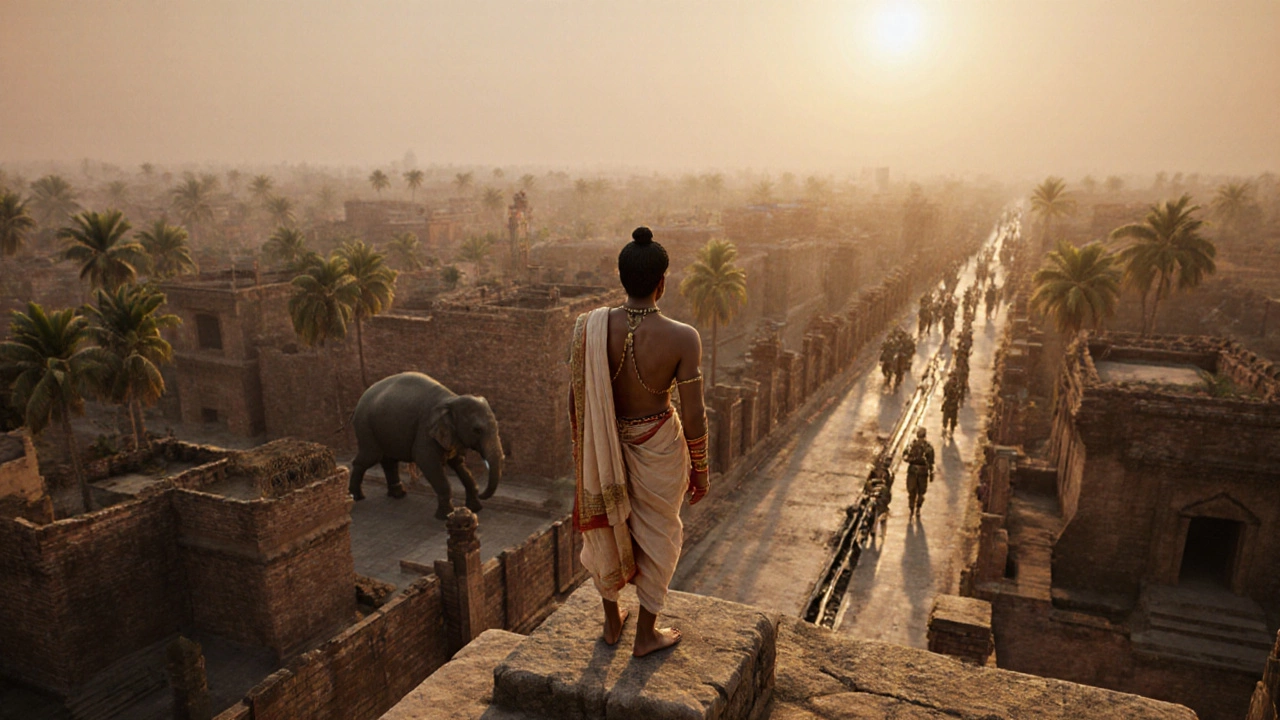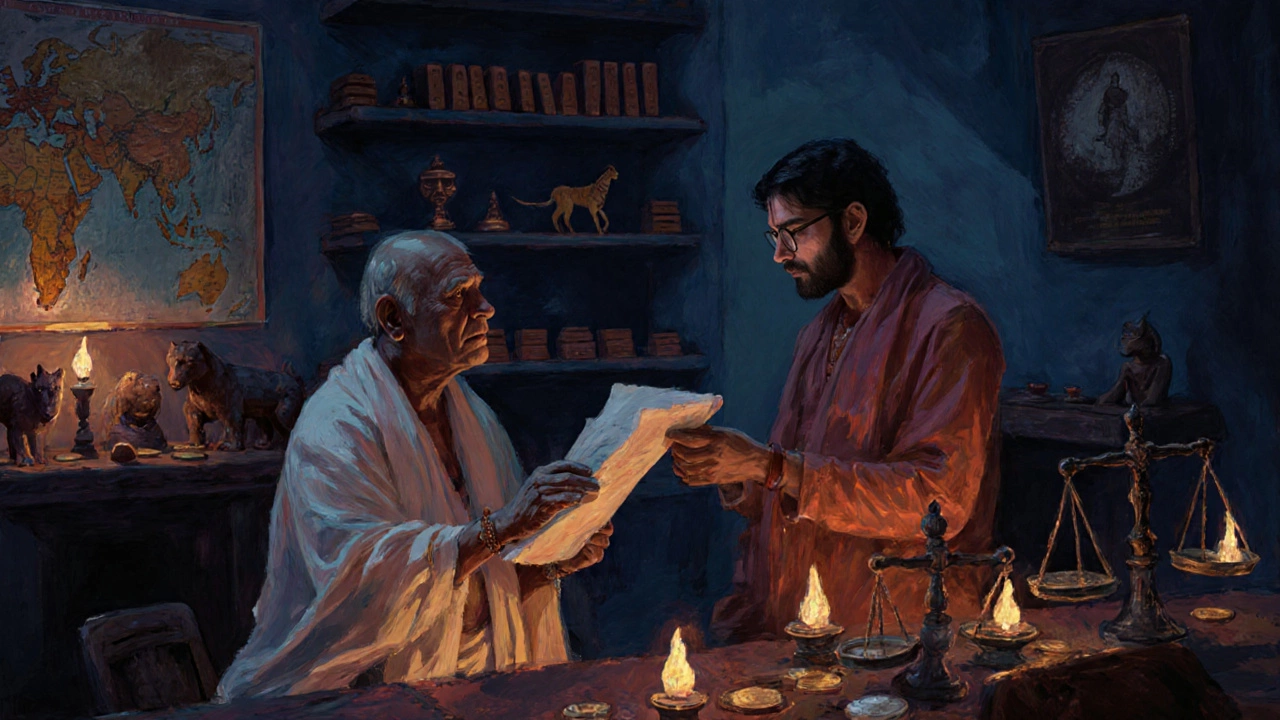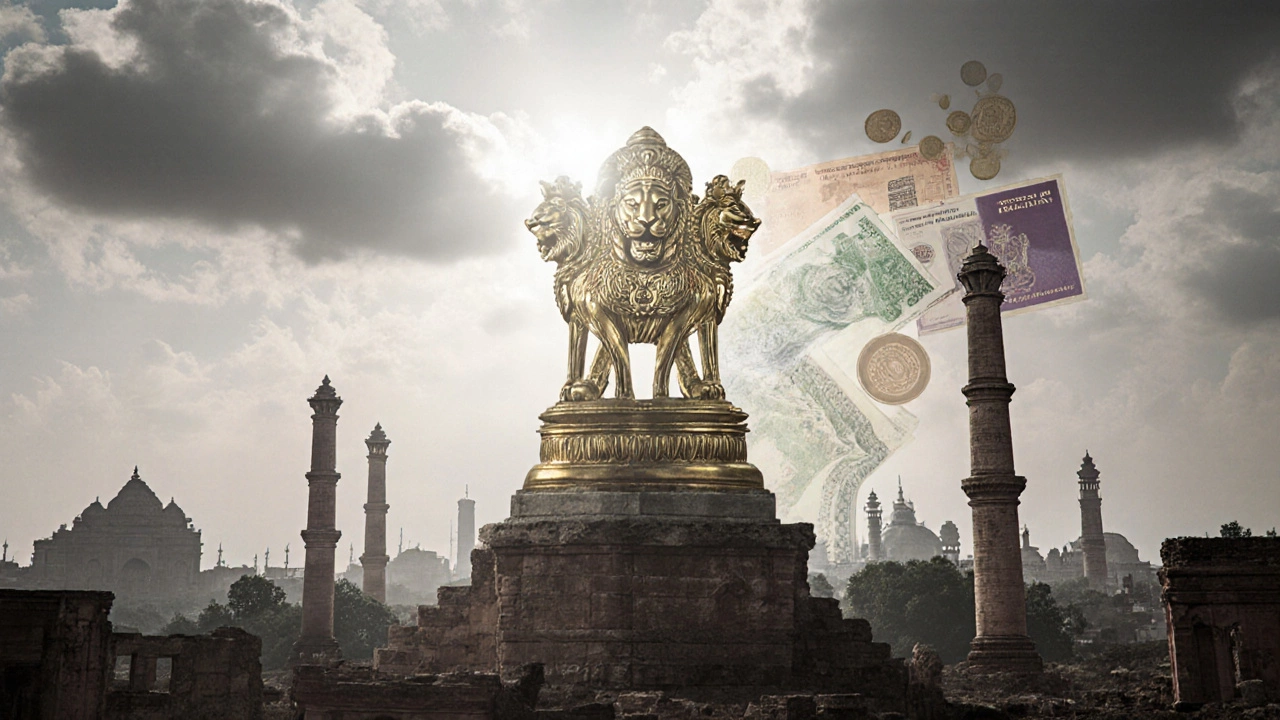Who Ruled India First? The Real Story Behind India’s First Ruler
 Oct, 28 2025
Oct, 28 2025
Indian History Timeline
Charting India's Unified History
Explore the timeline of Indian history from ancient civilizations through the establishment of the first unified empire. This interactive timeline highlights the Maurya Empire as the first true empire to unite most of the Indian subcontinent.
Key Historical Periods
Advanced urban societies with cities like Mohenjo-Daro and Harappa, but no evidence of centralized political rule.
16 independent city-states that controlled different regions, but none unified the subcontinent.
Founded the Maurya Empire by uniting most of the Indian subcontinent under one centralized government. This was the first true empire in Indian history.
Chandragupta's grandson Ashoka expanded the empire and spread Buddhism across Asia through his rock edicts and missionary efforts.
The empire fragmented into smaller kingdoms after the death of Ashoka.
Established by Babur, but came nearly 1,800 years after Chandragupta's empire.
British rule began after the Indian Rebellion of 1857, over 2,000 years after the Mauryas.
When people ask who ruled India first, they’re often thinking of kings in colorful robes or epic battles from movies. But the real answer isn’t found in Bollywood epics-it’s buried in stone inscriptions, ancient texts, and the ruins of a civilization that built the first true empire on the subcontinent. And it starts with a man named Chandragupta Maurya.
Chandragupta Maurya: The Man Who Unified India
Before there was Akbar, before the Mughals, before the British, there was Chandragupta Maurya. Around 322 BCE, he took control of the city of Pataliputra (modern-day Patna) and began building what historians now call the Maurya Empire. This wasn’t just another kingdom. It was the first empire to bring together most of the Indian subcontinent under one centralized government.
He didn’t inherit power. He seized it. With help from his advisor Chanakya-a teacher, strategist, and author of the Arthashastra-Chandragupta overthrew the Nanda Dynasty, which ruled the Ganges plain. He then pushed west, defeating Seleucus I Nicator, a general of Alexander the Great who tried to reclaim parts of northwest India. That victory gave Chandragupta control over areas that are now Afghanistan and parts of Pakistan.
His empire stretched from Bengal in the east to Balochistan in the west, and from the Himalayas in the north to the Deccan Plateau in the south. For the first time in recorded history, a single authority governed land that included dozens of languages, cultures, and religions. That’s not just ruling-it was nation-building.
How Did He Do It? The Mauryan Machine
Chandragupta didn’t rule through charisma alone. He built a system. The Mauryan Empire had a bureaucracy that would make modern governments jealous. There were ministers for agriculture, trade, roads, spies, and even animal welfare. Cities had public wells, hospitals, and organized police forces. Taxes were collected efficiently, and grain stores kept the population fed during droughts.
Chanakya’s Arthashastra-a 2,300-year-old manual on statecraft-laid out how to run an empire. It included advice on espionage, diplomacy, economic policy, and even how to handle rebellions. It wasn’t theory. It was practice. And Chandragupta followed it.
Archaeological digs in Pataliputra uncovered wooden palisades, brick buildings, and drainage systems that match descriptions in ancient texts. Coins from his reign, stamped with symbols of animals and royal insignias, have been found across northern India. These aren’t myths. They’re evidence.
Who Came Before Him? The Forgotten Kingdoms
Some will argue that earlier rulers like the Mahajanapadas-16 powerful city-states from 600 BCE-count as "first." But those were independent kingdoms, not a unified empire. Think of them like rival football clubs. Each had its own rules, its own army, its own king. None controlled the whole field.
Others point to the Indus Valley Civilization (3300-1300 BCE), which had advanced cities like Mohenjo-Daro and Harappa. But there’s no proof they had kings, written laws, or centralized rule. We don’t even know what they called themselves. They left behind seals and pottery, but no records of rulers. So while they were advanced, they weren’t an empire in the political sense.
Chandragupta’s empire was the first to leave behind clear proof of administration, taxation, diplomacy, and military control over vast territory. That’s what makes him the first true ruler of India.

What Happened After Him?
Chandragupta didn’t stay on the throne forever. Around 298 BCE, he gave up his crown. He walked away from power, became a Jain monk, and fasted to death-a final act of spiritual surrender. His son Bindusara took over, and his grandson Ashoka became one of the most famous rulers in world history.
Ashoka turned the empire into a beacon of peace after the bloody Kalinga War. He sent Buddhist missionaries to Sri Lanka, Greece, and Egypt. His rock edicts, carved into cliffs and pillars across India, are still readable today. But without Chandragupta’s foundation, Ashoka’s empire wouldn’t have existed.
The Maurya Empire lasted about 140 years. After it collapsed, India fractured again into smaller kingdoms. But the idea of a unified India? That stayed. Every future empire-from the Guptas to the Mughals-used the Mauryan model as a blueprint.
Why Does This Matter Today?
When you watch a Bollywood movie about ancient India, you’ll often see kings with gold crowns and war elephants. Those films are entertainment. They’re not history. The real story of India’s first ruler is quieter, more complex, and far more impressive.
Chandragupta Maurya didn’t need dramatic music or slow-motion battles. He built institutions. He created systems. He made a country out of chaos. That’s the kind of leadership that lasts.
Today, when India’s constitution speaks of "unity in diversity," it’s echoing the same idea Chandragupta mastered over two millennia ago: that different people, languages, and beliefs can live under one government. That’s not just history. It’s the foundation of modern India.

Myths vs. Facts: Clearing Up Common Misconceptions
- Myth: The Mughals were India’s first rulers. Fact: They arrived in 1526-almost 1,800 years after Chandragupta.
- Myth: The Vedas mention kings who ruled all of India. Fact: The Vedas describe tribal societies, not empires. They’re religious texts, not historical records.
- Myth: Alexander the Great conquered India. Fact: He reached the Punjab region but was turned back by Indian armies. Chandragupta later took control of those same lands.
- Myth: There was no organized government before the British. Fact: The Mauryas had postal systems, standardized weights, and public works decades before Rome’s peak.
Where to See the Evidence Today
You don’t need to read ancient Sanskrit to see Chandragupta’s legacy. Visit the Ashoka Pillars in Sarnath or Lauriya-Nandangarh. The polished sandstone, the lion capitals, the inscriptions-they’re all remnants of his empire. The National Museum in Delhi has Mauryan coins and artifacts. The ruins of Pataliputra lie beneath modern Patna, still being uncovered by archaeologists.
Even the Indian national emblem-the Lion Capital of Ashoka-is directly taken from Mauryan art. That’s right: the symbol on every Indian passport, currency, and government letterhead comes from the first empire India ever had.
Who was the first ruler of India?
Chandragupta Maurya was the first ruler to unify most of the Indian subcontinent under a single empire around 322 BCE. He founded the Maurya Dynasty and established the first centralized administration in Indian history.
Did any empire rule India before the Mauryas?
Before the Mauryas, there were 16 powerful kingdoms called Mahajanapadas, but none controlled the entire region. Earlier civilizations like the Indus Valley had advanced cities, but there’s no evidence they had kings or centralized rule. The Mauryas were the first to create a true empire.
Was Alexander the Great the first ruler of India?
No. Alexander invaded parts of northwestern India in 326 BCE but never ruled the region. His forces turned back after facing strong resistance. Chandragupta Maurya later took control of those same areas and built a much larger, lasting empire.
How do we know Chandragupta Maurya really existed?
Multiple sources confirm his existence: Greek historians like Megasthenes wrote about him, Indian texts like the Arthashastra describe his administration, and archaeologists have found Mauryan coins, pillars, and city ruins across northern India. His empire left behind physical and written proof.
Why isn’t Chandragupta as famous as Ashoka?
Ashoka became famous because he embraced peace after war and spread Buddhism across Asia. His edicts were carved in stone and widely copied. Chandragupta built the empire, but Ashoka made it legendary. Think of Chandragupta as the architect and Ashoka as the public face.
Final Thought: The Real Legacy
India didn’t become a nation because of colonial borders or modern politics. It became a nation because someone, over 2,300 years ago, decided that unity was possible. Chandragupta Maurya didn’t just rule-he created the idea of India as a single political entity. That’s the real answer to "who ruled India first." And it’s not a myth. It’s history.